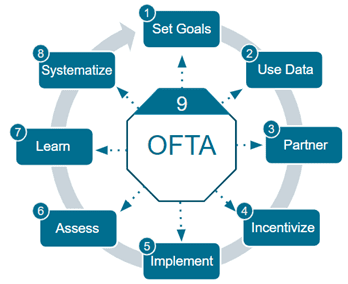How to Design An Outcomes Focused Federal GovernmentSix Recommendations for the Biden Administration
500% increase in workforce enrollment and program completion for previously underserved youth in a workforce development program in Virginia
33% reduction in psychiatric emergency room visits by chronically homeless in California
50% fewer days in jail and 61% fewer arrests for high-risk, high-need criminal offenders in Utah
22% improvement in speedy access to mental health and case management services for underserved clients in Oregon
When state and local government agencies have the necessary knowledge, resources and support to change the way they design, deliver and assess human services, people served by public systems measurably improve their lives.
The Case for an Outcomes Focused Government Paradigm

Federally funded human services (healthcare, community development, food assistance, workforce, education, reentry, housing, child support etc.) are successful when they consistently achieve improved and more equitable outcomes for the people they serve. Yet many such services fall short of their potential due to SYSTEM INEFFICIENCIES and SYSTEMIC RACISM. Given its commitment to racial equity and building back better, the Biden administration is well positioned to help state and local governments gain the knowledge, resources, and capacity they need to re-orient policies, practices and behaviors in support of improved and equitable outcomes.
In order to better help state and local governments, the Biden Administration, led by OMB and DPC, should work to adjust federal financial and regulatory policy, technical assistance and management practices in support of an outcomes focused government (OFG) system change paradigm.
Components of the OFG Paradigm
The OFG paradigm is a proven system change approach that encompasses eight components necessary to reorient policy, practices and behaviors in support of improved and more equitable outcomes. The paradigm starts by establishing a clear goal for a given population which can be as small as improving kindergarten readiness for pre-k children in a given county and as big as improving economic mobility for racial minority youth in an entire state.
Once goals are established, the lead government agency, moves through the OFG Paradigm components to use and analyze quantitative and qualitative data to uncover barriers and equities; establish partnerships to break down silos; incentivize outcomes over outputs; implement evidence-informed practices; assess progress; learn through continous improvement structures; and systematize effectives management practices.
Outcomes Focused Technical Assistance (OFTA) is a ninth and central element as it makes it possible to systemically and sustainably work through and facilitate change management with the other components. Addressing one component without the others runs a high risk of perpetuating silos or making a narrow adjustment to a single process or program that doesn’t last over time.
Recommended steps to enable the OFG Paradigm
1. Set a vision and strategy for the US human services system
Since individuals accessing services have a myriad of complex, evolving and compounded needs, federal (and state agencies) should work together to develop, manage, oversee and evaluate human services. In order to work as a coherent system with each agency supporting a piece of a whole, the DPC should lead a collaborative, human-centered effort with human service agencies (HHS, USDA, HUD, DOL, Dept of Ed, DOJ and CNCS) to develop a vision, mission and strategic plan for the entire US human service system.
2. Conduct and outcomes review and update regulatory guidance
To ensure that the regulations that govern human service delivery are in support of outcomes (rather than barriers to overcome), we recommend that OMB and DPC work with the human service agencies and state and local practitioners to conduct an outcomes review across human service programs with a particular focus on uncovering outcome and equity barriers. DPC, OMB and agencies can then work to update respective regulatory, legislative and executive guidance, rules and resources to make it easier for state and local agencies to adopt the OFG paradigm.
3. Increase outcomes focused TA (OFTA)
Technical Assistance (TA) is widely used by federal agencies to assist states, localities, non-profits and other grantees in implementing their programs. To expand the use of federal TA for outcome (rather than compliance) purposes, OMB and the DPC should lead an effort to provide human service agencies with guidance and support on how to engage OFTA for itself while also making it more readily available to state and local governments.
4. Assign federal responsibilities for state/local outcomes
OMB should appoint a senior official to coordinate and support inter-agency efforts to diffuse the OFG paradigm to state and local levels. Each human service agency should similarly designate a State and Local Outcomes Offices who reports directly to the Performance Improvement Officer (PIO).
5. Create interagency OFG Council
The DPC or OMB should create an interagency Council of State and Local Outcomes Officers with three purposes: 1) implement relevant aspects of the human service strategy 2) serve as a learning community to identify and promote best practices developed in enhancing State and Local outcomes, and 3) develop cross-agency strategies to meet emerging issues and challenges.
6. Build federal capacity for outcomes management
Federal program, contracting, data, finance, legal and other staff need training and coaching on how to use their positions to drive improved and more equitable outcomes. OPM should therefore offer an “outcomes management” competency model through the Federal Executive Institute as well as through partnerships with university programs.
